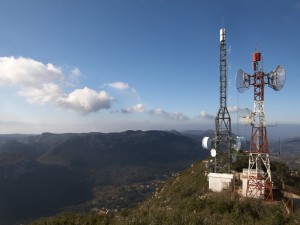 A new radio developed by a startup from Stanford has demonstrated a way to send and receive data on the same frequency, which could double the bandwidth of wireless networks. The company, Kumu Networks, appears to have solved this old challenge to radio communications, in theory, with this new circuit and algorithm.
A new radio developed by a startup from Stanford has demonstrated a way to send and receive data on the same frequency, which could double the bandwidth of wireless networks. The company, Kumu Networks, appears to have solved this old challenge to radio communications, in theory, with this new circuit and algorithm.
Kumu Networks
Kumu Networks plans to start trial of its technology using major wireless carries early next year. The full-duplex radio tackles “self-interference,” an issue that arises because the transmissions that radios send are usually billions of times stronger than incoming signals, disrupting any attempt to receive data on the same frequency. This is why most radios, including your smartphone and Wi-Fi routers, send information out on one frequency and listen on another or at least have some intelligent frequency toggling in place.
This limitation has forced us to use our wireless spectrum inefficiently, until now perhaps! Kumu’s extremely fast circuit can predict, at any given moment, exactly how much interference a radio transmitter is about to transmit, and then generate an equal compensatory signal to cancel that out. The technology interestingly should work with mobile devices, too, since it creates a new signal with each data packet sent. “This was considered impossible to do for the past 100 years,” says Sachin Katti, an assistant professor of electrical engineering and computer science at Stanford, as well as Kumu’s chief executive officer and co-founder.
 According to the MIT Technology Review, other companies like satelitte modem maker Comtech have used self-cancellation before to boost the bandwidth of satellite communications. The Stanford team, however, is the first to demonstrate how self-cancellation could be used in commercial networks like LTE and Wi-Fi.
According to the MIT Technology Review, other companies like satelitte modem maker Comtech have used self-cancellation before to boost the bandwidth of satellite communications. The Stanford team, however, is the first to demonstrate how self-cancellation could be used in commercial networks like LTE and Wi-Fi.
The Director of the Wireless Research Center at Virginia Tech Jeff Reed says this could be a breakthrough advance in communication technology, but he is still cautiously awaiting the real life results:. “If their claims are true, those are some very impressive numbers,” Reed says. “It requires very precise timing to pull this off.”
“A lot of the spectrum is massively underutilized, and this is one of the tools to throw in there to make better use of spectrum,” says Muriel Medard, a professor at MIT’s Research Laboratory of Electronics.
This is a very exciting development that could be one of the most significant recent advancements in networking. Kumu has already received $10 million in financing from investors that include Khosla Ventures and New Enterprise Associates. Kati believes we could see benefits “on every wireless device in existence from cell phones and towers to Wi-Fi to Bluetooth and everything in between.”
So what do you plan on doing with your extra internet bandwidth soon?


